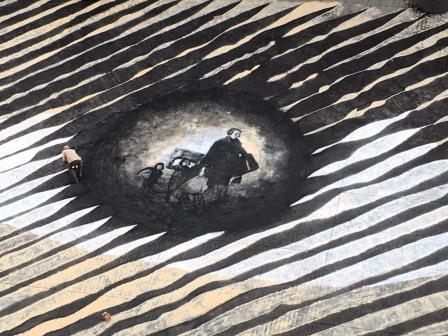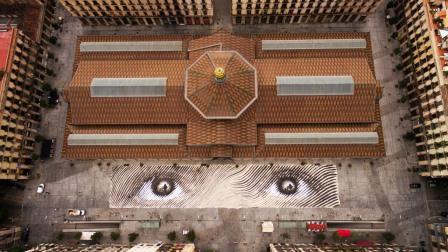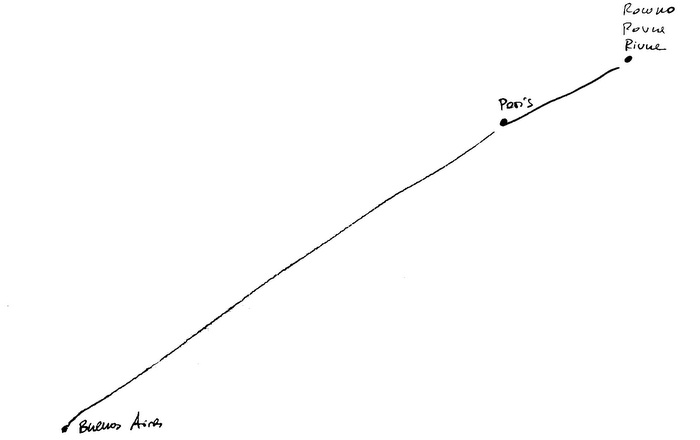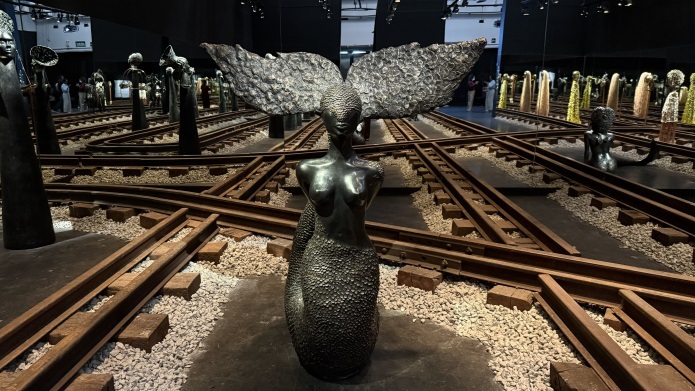
“RECORDAR means to pass through your heart. When a memory is relived we feel the same things that where lived and felt in the past.”
Jorge Rodríguez-Gerada, a Cuban born artist who was raised in the US and is currently a resident in Barcelona, has created one of the largest public artworks in Spain, measuring more than 23,500 square feet (2,200 square meters). The participative and ephemeral artwork covered the Plaza Comercial located in the Born section of Barcelona on October 1st, 2016. It was created with the help of local residents and more than 500 volunteers, had the philanthropic support of the small business association Born Comerç and the production support of Subagora Agency.
“Recordar” is an artwork that can be classified as an urban performance and was realized with the use of GPS technology provided by the company TopCon. The artwork was then filled in with the collaboration of volunteers using chalk spray paint. This ephemeral, non-toxic and washable paint was created by Montana Colors with a special formula that would not damage the pavement and came in recyclable cans.
RECORDAR
The name of the artwork refers, in an etymological sense, to the Latin term record?ri, composed by re (again) and cordis (heart). In this sense, it emphasizes that the act of remembering implies that a person, a situation or an object passes again through the heart of the person who recalls the memory. Through that memory, a person awakens, relives and feels the things that were lived and felt in the past, now actualized in the immediate reality of the moment.
Coming form a personal and family history that marks the artist´s identity, his own experience of being the child of Cuban exiles in the US and a grandchild of Spanish exiles in Cuba, the artwork Recordar aims to give homage to the 465.000 men, women, and children who between the years of 1936 to 1939 lived through the Spanish Republican exile and crossed the frontier to France in order to save their lives.
Recordar calls us to reflect upon the importance of our historic memory and the social problems that keep repeating themselves. The piece invites spectators to pass through their hearts those experiences, that as part of history conform our cultural legacy, so we can avoid repeating in the present the horrors and indifference of the past.

PUBLIC PARTICIPATION
A fundamental part of this urban performance is that the creation of the piece is done with spectator participation. With this vision of collective creation, passers by and local residents who had an affinity for the values and direction of the artwork were invited to paint with the artist.
Rodríguez-Gerada considers that this collaboration with the spectator generates dynamic relationships that help recover the sense of affinity while bringing into discussion our history, both collective and personal. The small business association of Born Comerç has financed this artistic initiative with the goal of enriching the sense of belonging among the neighbors and creating a sense of community around the creation of art.
ARTIST´S DECLARATIONS
“This artwork has allowed me to open a dialogue about an international problem, that is cyclical, about forgetting the horror. We as human beings do not look back often, many times we are not interested in knowing what happened to others, and this condemns us to continue to make the same mistakes. That is why this piece is a homage to all those who had to leave their countries due to war, as my grandparents did when they arrived in Cuba”.
“When you read about the treatment that the extreme right in France gave to the Spanish exiles during the Civil War, you realize that it is the same rhetoric that is being used in Europe about the Syrian refugees. People now talk in the same terms as if they are terrorists or bad people, that is why, more than ever, I want with this piece to try to recover the base meaning of the word, Recordar (Remember), so we pass al these memories again through our hearts”.
“This piece would not have the same meaning if it was not participative. This is very important, because it is not the work of just one person that is created in his studio with just one discourse; this is the message and the work of many people who come together to create a huge piece of art in a creative way. With Recordar, the artwork goes out to the streets, opens up to the city and touches it´s people”.
“We used ephemeral chalk spray paint that allowed me to create a kind of mandala on the city. It is my way of doing something creative that leaves a mark, but allowing it to fade away, and by disappearing it becomes a gift to add to our memory”.
“I have always had a real interest in the use of technology in my work. I have searched all my life for new canvases and frames to create on. I started altering billboards in New York City, then creating murals on the sides of buildings and later on the topography of the cities. I feel it is important for an artist of today to use the mediums of the moment, that way the artwork is truly contemporary. For me, technology allows me to do many different combinations. I have always looked upon artists like Leonardo da Vinci, who constantly changed the way they worked and continued to research mediums and ideas throughout their lives.”
ABOUT JORGE RODRÍGUEZ-GERADA
Born in Cuba in 1966, raised in the US and currently a resident in Barcelona, Jorge Rodríguez-Gerada is a visual artist internationally known for his innovative artistic work and for the multiplicity of technics that he applies in his prolific production.
Rodríguez-Gerada creates huge portraits in the public space, with a meditative component that is provoked when citizens walk over his pieces, obtaining a personal experience at ground level with art as the creative and social base.
His work, created in extraordinary large scales, is visible from space and needs to be photographed from the sky, even by satellites. The dimension of the artwork is intrinsic to the importance of what is being said, from questioning complex social issues, such as identity, human rights or climate change.
He has created his work in diverse places: Amsterdam, New Zealand, London, Sao Paulo and Bahrain are just a few examples. He has exhibited in galleries such as Galería N2 (Barcelona) and Galerie MathGoth (Paris) and has been part of prestigious publications about urban art such as the TATE Gallery catalogue in London, Street Art. The Graffiti Revolution (Cedar Lewisohn, 2008) o Designing Obama (Scott Thomas, 2009).















